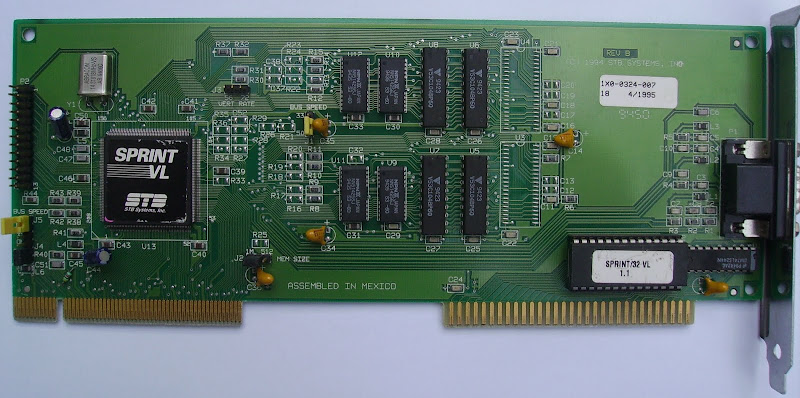First post, by retro games 100
- Rank
- l33t
Introduction
The mobo I'm using is a 486 VLB Opti Shuttle HOT 419, revision 1.1. The VGA card is a 1MB STB Sprint/32 VL, using the Trident chipset. BTW, STB stands for "Simply the best". However, with a Trident chipset onboard, perhaps they could have called it STW? Only joking. The card seems quite good. The multi IO controller is a VLB Prime 2C 9418. There's also a Promise PDC20230C chip on it.
I'm always interested in fast mobo bus speeds, and so I have set the mobo and VGA card to operate at 50 MHz, and I'm using an Intel DX-50 CPU. It's a shame that this mobo is an early revision. I think that later models can accept the AMD 5x86 P75 X5 CPU. Also, the voltage regulator has been removed from this mobo, meaning that only 5V CPUs are supported. Oh well.
Apparently, because I'm using 2 sticks of 8MB FPM (60ns), the mobo's memory configuration is in "mode 2", and the manual goes on to say that "if memory configuration mode 2 is selected, the 419 mainboard only supports one VESA master mode local-bus slot on J18 or J19, and J20 is assigned to slave." I guess that means that my VLB IO controller (in slot J20) is in slave mode. The system appears to be stable, and I wonder if that is because the IO VLB controller card is in slave mode, and not in master mode which is the mode that the VLB VGA card must be operating in.
Downloads
1) The IO controller came with a "blank media" 3.5 inch floppy diskette containing the 32-bit DOS and Windows 3 drivers. I have compressed the contents of this diskette using the 7z format, and you can download it here. (Filename is called IO.7z) I set the Windows 3.11 disk and file access options to "32-bit mode", and it seems to work. Unfortunately, I couldn't find a website that had jumper settings for this card.
2) I found the Trident VGA driver on DriverGuide. It was for version 1.2. The card I have has a BIOS chip with version 1.1 written on it. Luckily, this driver seems to work OK. I tested it in Windows 3.11 (wfwg). You can download it here. (Filename is called SPRINT_32_VL_v1.2.ZIP) I also tried the card in Windows 95. It automatically installed a driver called "Trident SVGA". Unfortunately, all of the desktop graphics were displayed in a very low resolution, and consequently everything was unreadable. Oh well. The good news is that this problem doesn't arise if you use Windows 98. The same thing happens, and that a Trident SVGA driver is automatically installed, but this time the driver doesn't behave oddly, and the desktop appears normally, in a sensible "hi res" resolution.
3) I had a look online for mobo jumper settings. I found them here. There's also a more comprehensive .PDF manual here, although it's for a later revision, and so some of its content is not applicable. I did notice at least one thing different with the first jumper settings link and my mobo, on this Stason website. It talks about jumper JP35, but there isn't one. Instead, there's a JP33 in its place, which seems to do the same thing. This jumper is to do with the VL bus speed.
Questions
1) What kind of IO controller do I have? Is it a GoldStar, or a Promise IO controller? Also, can anyone find the jumper diagram for it, please?
The mobo.

Some BIOS timings. I couldn't max them out. The reason is probably because I'm running at 50 MHz bus speed.

Mobo BIOS POST screen. BIOS id is 40-P3J3-DK1343-00101111-121593-OPTi895-H. I don't know if this is the latest version. Perhaps there is an update? If so, perhaps I can use an AMD 5x86 CPU in it, although the adsence of a voltage regulator on this mobo makes that awkward!

STB Sprint/32 VL (Trident) VGA.

STB Sprint/32 VL BIOS POST screen.

Trident screen configuration: AGi-UA6.11 That's lucky, I can select an LCD friendly refresh rate of 60 Hz. What's not so lucky is that the card only has 1MB, and this RAM amount is not expandable.

Goldstar Prime 2C 9418 / Promise PDC20230C IO controller. I've got a CF device attached as master, and an IDE DVD-ROM device attached as slave.

32-bit disk access and file access in Windows 3.11 Control Panel --> found in the 386 enhanced section.

WinTune 2.0 for Windows 3. Three comparison screenshots: RAM, Video and Disk. The results seem to be more than acceptable.



SpeedSys - the memory bandwidth score is good.

WinTune 98 - using Windows 98 with only 16MB of FPM.
